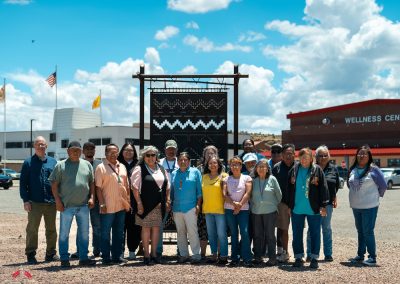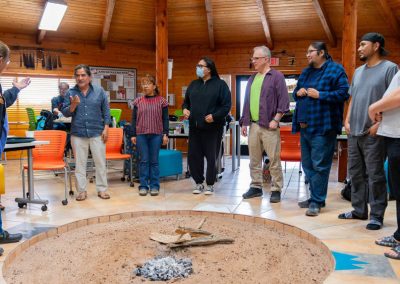The participants in this program are working on developing a series of online reference tools to assist language learners, teachers, and linguists with the grammar of Diné Bizaad. The program is headed by Assistant Professor Sharon Nelson and Professor Ted Fernald, and a grant from the National Endowment for the Humanities funds it. Dr. Fernald mentioned that Diné linguists have been studying the grammar of their language for more than a century and have published work on grammar as early as 1943 (Young & Morgan 1943). Additionally, Navajo-speaking linguists have been earning PhDs since the late 1970s, with the first being the late NTU professor Dr. Paul Platero and Dr. Ellavina Perkins, who are part of the current NLA program.
Dr. Fernald explains, “Our primary goal is to assist a new generation of Navajo speakers in embracing their cultural heritage. It’s important to emphasize that this program focuses equally on supporting elders and experienced teachers as it is on students.” The workshop assists Navajo linguists, language educators, researchers interested in Navajo or related languages, and graduate and undergraduate students.
This year, the NLA (Native Language Association) will begin a new collaboration with Zapotec language scholars from Oaxaca, Mexico. One of the esteemed scholars is Janet Chavez Santiago, a native speaker who passionately presented her groundbreaking research on the Teotitlan del Valle Zapotec Talking Dictionary. She provided detailed information about the project’s origins, which date back to 2012 with the Tlacolula Valley Zapotec Talking Dictionary. Janet enthusiastically shared, “The Oaxaca community and surrounding areas have shown a strong interest in expanding the dictionaries and developing authentic versions that represent the diversity of Zapotec languages spoken in their region.” Janet has also published a children’s book in her Zapotec language, which she shared with the audience.
Dr. Felipe H. Lopez, a native Zapotec speaker and co-author of materials for teaching his language, led the development of the San Lucas Quiavini Zapotec online talking dictionary. He also shared his research and work at NTU Hogan, focusing on family language policy, transnationalism, and the diaspora community of San Lucas Quiaviní in Oaxaca, Mexico. According to Dr. Lopez, “Zapotec languages are considered threatened because fewer and fewer people are acquiring them as native languages. Community and individual identity are closely tied to language, particularly in Mexico, where being recognized as part of an Indigenous community often depends on speaking the corresponding language.”
Additionally, Irene Silentman of Newcomb, New Mexico, and one of the developers of “Situational Navajo” in the 1990s, advocated for language courses that specifically focus on teaching verb forms to students.
The Navajo Language Academy, Inc., is a non-profit educational organization that is scientifically studying and promoting the Navajo language. It is a joint effort of professional language teachers and linguists. From 1997 through 2024, the academy hosted Navajo linguistics workshops for scholars every summer.
——————————–
For more information, contact:
Natalie R. Desiderio
Administrative Assistant
Graduate Studies & Undergraduate Diné Studies
E: ndesiderio@navajotech.edu
P: (505) 387-7520
Navajo Technical University continues to honor Diné culture and language while educating people for the future.
Dale Morgan, Communications Specialist
dmorgan@navajotech.edu
#####



